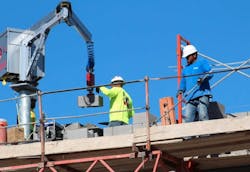Reconsidering construction robotics
Fact: There were 379,000 unfilled construction jobs in August, based on preliminary estimates released in October by the Bureau of Labor Statistics. Fact: The majority of nonresidential construction projects come in over budget and late, sometimes wildly so.
After decades when experts predicted that robots would become more prevalent on construction sites, it would appear that the industry has finally reached that point where necessity, aspiration, and investment are colliding.
In Illinois, two general contractors—Clark Construction Group and Blinderman Construction—are using robots provided by New York–based manufacturer Construction Robotics that are helping crews lay brick and hoist 32-inch foundation blocks faster and more efficiently for a $52 million, 166,000-sf barracks.
Scott Peters, Construction Robotics’ cofounder and CEO, says his company’s machines, dubbed MULE and SAM, have installed more than one million sf of walls. Peters also notes that more GCs and subcontractors are incorporating robots into the early planning stages of their projects.
Until recently, construction robotics has been mostly an academic exercise, with institutions such as the University of Southern California, MIT’s Media Lab, and Carnegie Mellon leading the charge. And what robots could perform was limited to a handful of tasks—rapid bricklaying, large-scale 3D printing for structures, and rebar tying.
The attraction of robots lies in their promise of lower operating costs, improved efficiency for repeatable tasks, on-demand and custom development (such as additive manufacturing and prefabrication), and better jobsite logistics and management.
A recent video produced for the widely watched channel The B1M highlights the growing number of companies building robotics that could have jobsite utility. These include Ekso Bionics (exoskeletons), Advanced Construction Robotics (rebar tying), Effidence (navigation), Doxel (automated vehicles with LIDAR and cameras for site inspection), and Boston Dynamics, whose owner, Softbank, last February kicked another $37 million into that company.
The market research firm Tractica projects that the annual global market for construction robots would expand nearly tenfold, to $226 million, between 2018 and 2025. Over that period, Tractica expects 7,000 new construction and demolition robots will be deployed.
“In the future, I do think we’ll see a lot of autonomous equipment out on job sites,” Noah Ready-Campbell, Founder and CEO of Built Robotics, told Robotics Business Review earlier this year. But Ready-Campbell qualifies that comment when he states, almost defensively, “I also would emphasize that we’ll need plenty of workers, too. People are just much better at improvising and making judgment calls, and that’s critical, especially in the early stages of a product.”
Sound familiar? This is the same rejoinder that tech companies fall back on when pitching software that seems threatening to human workers.
What’s different about the construction industry’s situation, however, is that many experts doubt that the industry’s prolonged labor shortage is reversible. Robots might be the only way for developers and their AEC partners to come close to meeting demand in an increasingly urbanized built environment.
Given that outlook, construction robots make more sense now than ever. The question is how many GCs and subs are willing to take that leap, and when.

